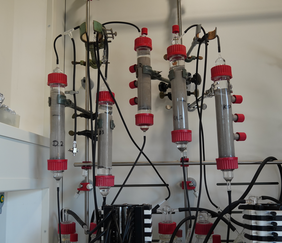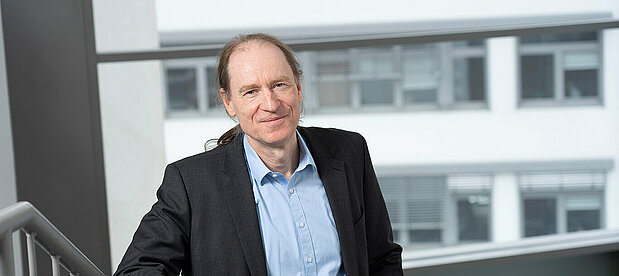With EiCLaR, an EU/China consortium, scientific and technical innovations for in-situ bioremediation processes were promoted. As part of the project, combined electro-bioremediation processes for the remediation of chloroethene-contaminated groundwater were investigated at TZW. New bioaugmentation technologies and molecular biological monitoring methods were developed.
Groundwater quality worldwide is negatively affected by the input of a wide variety of pollutants. One of the most common groups of pollutants found are volatile chlorinated hydrocarbons (CHCs), which are for example used as solvents. As groundwater is the most important source of drinking water, the protection of resources and the remediation of contaminated groundwater is of particular importance.
EiCLaR, an EU/China consortium with 13 European and five Chinese partners, has been driving scientific and technical innovations for in-situ bioremediation, which are directly incorporated into processes for the rapid, effective and cost-efficient treatment of a wide range of environmental pollutants such as chlorinated solvents, heavy metals, pesticides, etc. These technologies (Electro-Nanobioremediation, Monitored Bioaugmentation, Bioelectrical Remediation, Enhanced Phytoremediation) enable the extension of the application areas to industrial sites and waters containing a complex mixture of pollutants.
Research at TZW focussed on bioaugmentation processes and bioelectrical remediation processes for chlorinated hydrocarbons. The bioaugmentation potential of aerobically productive trichloroethene (TCE) degraders has already been demonstrated at TZW. As part of the EiCLaR project, these studies were continued and the application of bioaugmentation was investigated.
The electrochemical provision of electron donors and acceptors, in the form of hydrogen and oxygen, to stimulate sequential anaerobic/aerobic chloroethene degradation was investigated and the potential was demonstrated in column experiments. The amount of oxygen produced was regulated and the process controlled by adjusting the current. The targeted use of aerobically productive TCE-degrading bacteria, known as ‘bioaugmentation and biostimulation’, to utilise aerobic degradation at contaminated sites has been investigated and successfully applied on a larger scale in the laboratory and in the field. A reliable qPCR method based on genome analyses of the specialised bacteria was developed for improved observation of processes occurring in groundwater, which allows a quantification of the potential of aerobic TCE degradation in the field or the activity of the organisms in laboratory tests.
Overall, the concept for monitored bioaugmentation was developed in detail and methods for monitoring were provided so that it can be considered and used for the remediation of chloroethene-contaminated sites with aerobic degradation potential. This avoids the formation of undesirable metabolites and by-products that are relevant when using anaerobic degradation processes, an thus brings many benefits for contaminated sites.
The investigations into aerobic TCE degradation and the utilisation of bioaugmentation are being further intensified in a new research project. The BMBF-funded ‘ChloroBioRem’ project is focussing primarily on the targeted improvement of functional biodiversity at contaminated sites.
Publications
Hertle, Steffen; Boni, Nick de; Schell, Heico; Tiehm, Andreas (2023): Electrochemical biostimulation of aerobic metabolic TCE degradation in a bioaugmentation approach. In: Environmental science and pollution research international 30 (49), S. 107673–107680. DOI: 10.1007/s11356-023-29839-1
Gaza, Sarah; Schmidt, Kathrin R.; Weigold, Pascal; Heidinger, Michael; Tiehm, Andreas (2019): Aerobic metabolic trichloroethene biodegradation under field-relevant conditions. In: Water Research, S. 343–348. DOI: 10.1016/j.watres.2018.12.022
Lohner, Svenja T.; Becker, Dirk; Mangold, Klaus-Michael; Tiehm, Andreas (2011): Sequential reductive and oxidative biodegradation of chloroethenes stimulated in a coupled bioelectro-process. In: Environmental science & technology 45 (15), S. 6491–6497. DOI: 10.1021/es200801r
Schmidt K.R., Tiehm A. (2011): Natural Attenuation am Chlorethen-Standort Frankenthal: Bedeutung des sequentiell anaerob-aeroben Bio-Abbaus. Altlastenspektrum 05.11: 212-219
Lohner, Svenja T.; Tiehm, Andreas (2009): Application of electrolysis to stimulate microbial reductive PCE dechlorination and oxidative VC biodegradation. In: Environmental science & technology 43 (18), S. 7098–7104. DOI: 10.1021/es900835d

![[Translate to English:] Prüfstelle-Produktprüfung_Teststand Test centre and product testing](/fileadmin/_processed_/0/9/csm_TZW-Karlsruhe_Pruefung_Geraete-Teststand_377188946c.jpg)
























![[Translate to English:] [Translate to English:]](/fileadmin/_processed_/7/f/csm_Eiclar_EU_Logos_gross_86676e09f4.jpg)
![[Translate to English:]](/fileadmin/_processed_/3/7/csm_Eiclar1_7166b0d563.jpg)

![[Translate to English:] [Translate to English:]](/fileadmin/_processed_/6/6/csm_Eiclar_EU_Logos_39cc177d0e.jpg)
![[Translate to English:]](/fileadmin/_processed_/8/4/csm_Eiclar_EU_Logos_gross_01_79df89690e.jpg)
